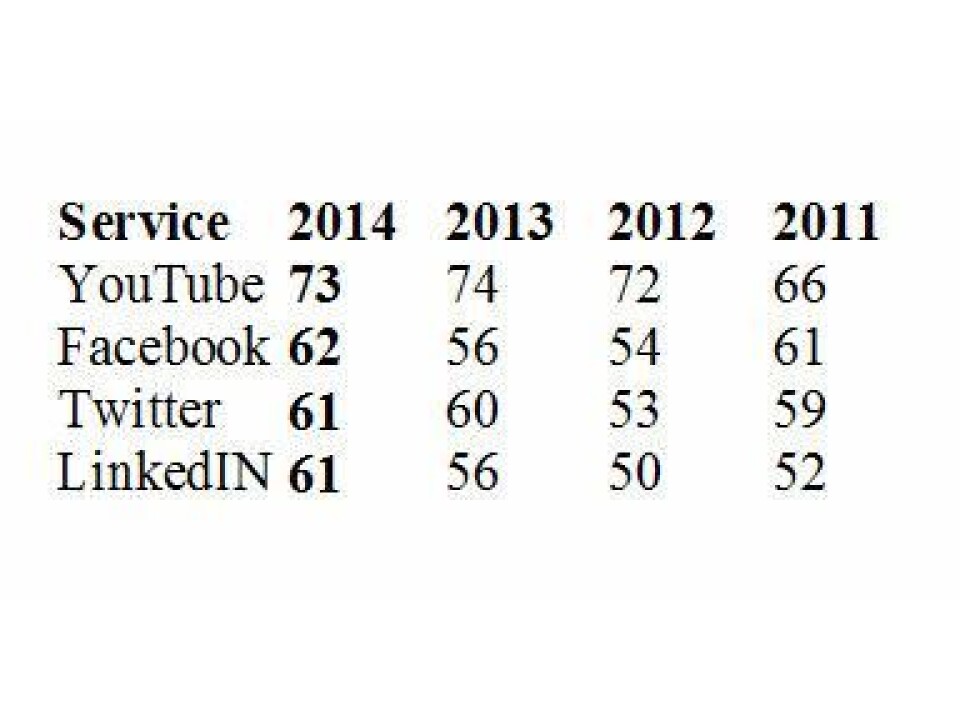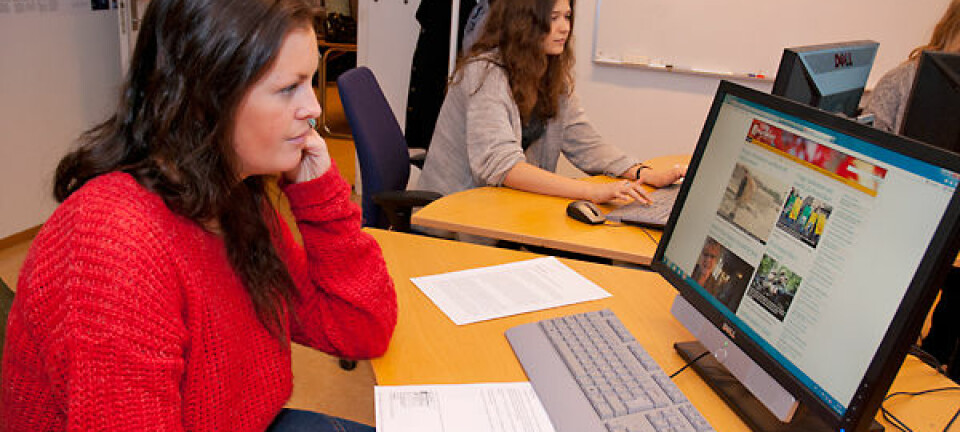This article was produced and financed by BI Norwegian Business School
Even more hooked on social media
Although Norwegians are not very satisfied with the services, more and more will continue to use Facebook and other social media.
Denne artikkelen er over ti år gammel og kan inneholde utdatert informasjon.
About 3 million people in Norway (of a total of 5,1 mill) have a profile on the internet community Facebook. The service has assumed the position of Norway’s largest media, and has become bigger than the national television channel NRK, the tabloid online newspaper VG and the commercial television channel TV2.
However, we are not particularly happy with the services, concludes a study released by the research project Norsk kundebarometer (The Norwegian Customer Satisfaction Index) at BI Norwegian Business School.
No likes for Facebook
Facebook scores 62 of a maximum of 100 points in terms of customer satisfaction, concludes a 2014 survey carried out by the Norsk Kundebarometer.
The score is nothing short of mediocre, indicating that users are underwhelmed by the service.

Norwegian Facebook-users are just as dissatisfied with the service as their American counterparts, according to a similar survey carried out in the United States (figures from the American Customer Satisfaction Index, 2013).
However, Facebook is up six points as regards customer satisfaction in Norway, from last year’s 56 points.
More loyal users
Although customers and users that are dissatisfied with services often consider leaving the services, this is not the case for Facebook users. The company achieved a score of 83 out of 100 loyalty points.
Facebook-user loyalty has risen dramatically during the past two years, and is up 9 points since 2012, when it scored 74 loyalty points.
In other words: we plan to go on using Facebook, even though we are not very happy with it.
“It is curious that loyalty remains so high, when customer satisfaction is disappointing. Facebook appears to have succeeded in gaining captive customers. We want to be where everybody else is,” explains Pål R. Silseth, project director at Norsk Kundebarometer at BI.
Norwegian users under the magnifying glass
For the fourth year running, Norsk Kundebarometer at BI has measured customer satisfaction and loyalty for four different social media: Facebook, LinkedIn, Twitter and the video-sharing service YouTube.
Each of these services has been assessed by 100 active service users in Norway. Users have been asked how satisfied they are with the service overall. They have also been asked to assess whether the service meets expectations, how attractive it is compared to other services, and how closely it approximates the idea of an ideal service.
And the winner is ...
The video-sharing service YouTube achieved 73 customer satisfaction points in this year’s survey - only marginally down on last year’s score of 74 points.
Of the services measured in the category social media, YouTube has the most satisfied users.
However, YouTube scores far below this year’s Norwegian winner, Flytoget - the Airport Express Train - which achieved 86.2 customer satisfaction points.
Despite the slight decline in customer satisfaction, YouTube continues to gain loyalty among its users. Three years ago, in 2011, YouTube attained a loyalty score of 80 points.
Loyalty has risen since then, and this year the company scored a whopping 91 loyalty points. We have got hooked on YouTube, and intend to go on using the service.
Advancing
The professional networking service LinkedIn can claim the largest growth in number of users over the past year, and now exceeds 1.1 million users in Norway. Over the past three years, the service’s users have become more satisfied. LinkedIn is assuming a powerful position in the lucrative employment marketplace, and may challenge Finn.no.
This year, LinkedIn achieved 61 of 100 possible customer satisfaction points, leaving the company well behind Finn.no’s 81.2 points. But it is worth noting that LinkedIn has moved up no less than 11 points over the past two years.
In 2012, the company achieved a mere 50 points.
In addition, users of LinkedIn have become more inclined to remain on LinkedIn. Loyalty has moved from 61 to 83 loyalty points, a rise of 22 points, over two years. Finn.no on the other hand scored 87.3 points in this year’s survey.
Several employers have created profiles on LinkedIn, and encourage potential applicants to follow them on the professional networking service.
“If many businesses leave their mark on LinkedIn, the website’s utility value from the point of the network’s users will rise significantly,” observes Silseth.
Minor changes for Twitter
The microblogging service Twitter has more than 300,000 user profiles in Norway. Like the other services evaluated in the survey, the users are not very satisfied with the service. Twitter scored on a par with LinkedIn this year, and gained 61 customer satisfaction points.
Compared with 2013, Twitter is up one customer satisfaction point; loyalty on the other hand dropped one point since last year, and is now at 75. This is the lowest loyalty score in the category social media, meaning that Twitter has the largest percentage of users thinking about spending their time not twittering.
------------
Read the Norwegian version of this article at forskning.no




































